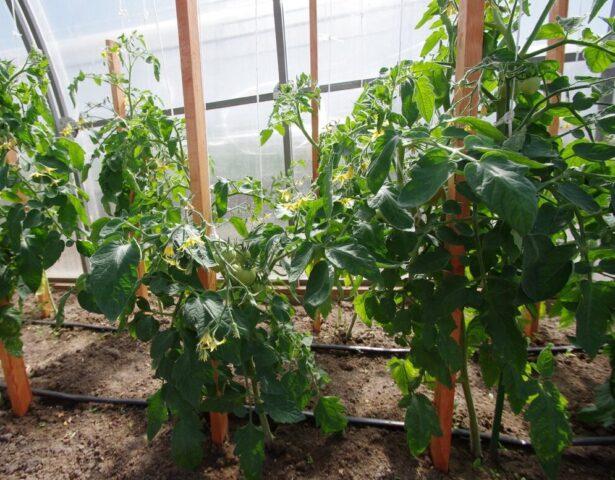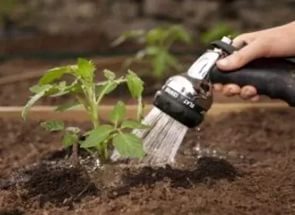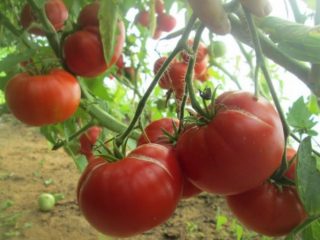Content
- 1 History of appearance
- 2 Description of the tomato variety Daddy's Daughter F1
- 3 Characteristics of tomatoes Daddy's daughter
- 4 Advantages and disadvantages of tomato Daddy's daughter
- 5 Features of agricultural technology
- 6 Pest and disease control
- 7 Conclusion
- 8 Reviews from gardeners about the Daddy's Daughter tomato
Tomato Daddy's Daughter F1 is a high-yielding, early-ripening, determinate hybrid. Designed for cultivation in open ground and under film covers, resistant to extremely high temperatures.
History of appearance
The hybrid Daddy's Daughter was bred by breeders of the agricultural company "Partner". The tomato has passed all the necessary tests and quality checks. Included in the State Register of Russia in 2021. Originator – V.I. Blokin-Dream.
Description of the tomato variety Daddy's Daughter F1
Tomato Daddy's daughter is a hybrid. This means that seeds of this variety should be purchased annually. Seedlings grown from planting material collected with one's own hands will not produce the harvest that the gardener expects. Unlike parent hybrids, less ovary is formed on it.
The Daddy's Daughter tomato bushes do not exceed 60-100 cm in height. The plants need staking and pinching.The leaves are of a regular shape, medium in size, and colored emerald green.
Tomato fruits are bright crimson in color, rounded-heart-shaped with an elongated nose. The brushes are semi-compound, each with 6-10 ovaries. The first inflorescence is formed above the 6-7th leaf, the next ones - after two. Berries weighing from 140 to 160 g. The pulp is juicy and fleshy. The taste quality is assessed by the originator as excellent. The skin is soft and tender, the fruits are not prone to cracking and tolerate transportation well.
Characteristics of tomatoes Daddy's daughter
Hybrid Daddy's Daughter F1 withstands drought and high air temperatures. Even in the most unfavorable conditions, tomatoes do not crack, do not dry out, and the ovaries do not fall off.
Tomato yield Daddy's girl
From the emergence of seedlings to the ripening of the first fruits, 95-100 days pass. The hybrid Daddy's Daughter is a high-yielding hybrid.

In open ground, up to 16 kg is harvested from 1 m2, in a greenhouse – up to 22 kg
Resistance to diseases and pests
The hybrid is endowed by its parents with good immunity. But violation of agrotechnical standards leads to its weakening. Then the plant is susceptible to fungal infections, and the bush may die from an invasion of parasites.
How to use
Tomato fruits Daddy's daughter F1 are universally used. The berries are consumed fresh and prepared for the winter. They are suitable for canning, making juices, ketchups, sauces, and lecho.
Advantages and disadvantages of tomato Daddy's daughter
A new product from the agricultural company “Partner”, the hybrid Daddy’s daughter needs a mandatory garter. The grower recommends keeping bushes with three stems.

Tomato Daddy's daughter light-loving variety
Pros:
- high productivity;
- immunity to brown spot, blossom end rot, fusarium;
- the fruits are thin-skinned, but not prone to cracking, retain their presentation for a long time, and can withstand transportation;
- resistance to heat.
Minuses:
- low germination of planting material;
- seeds must be purchased annually.
Features of agricultural technology
To get ripe fruits already in mid-July, it is recommended to grow the hybrid in seedlings. Sowing of seeds is carried out in early March, 55-60 days before the intended planting in open ground or under film covers. The disinfected container is filled with soil mixture, then the seeds are laid out. The originator of the variety recommends soaking them before planting. This procedure increases germination by 30%.
After sowing, cover the container and transfer it to a warm room. The first shoots will appear in 7-10 days. After this, the film is removed. In the phase of 2-3 leaves, the seedlings are planted in separate glasses.
Two weeks before transplanting into open ground, seedlings are hardened. The time the seedlings spend in the air is gradually increased. In the last 2-3 days, tomato seedlings are left to spend the night outside.
Site selection
Tomato Daddy's daughter F1 is a light-loving variety. For its cultivation, select a site that receives sunlight throughout the day. When grown in open ground, cabbage, legumes, and zucchini are considered good predecessors. It is not recommended to plant in areas where nightshade crops grew last year.
Planting scheme

More than four seedlings should not be planted per 1 m2
The bushes of this variety are quite spreading. Densely planted plants will block the access of sunlight to neighbors.In shading, plants slow down their growth, stop developing and bearing fruit. Recommended planting pattern for tomatoes – 50x60 cm
When transplanting seedlings, they try to transfer the root along with a lump of earth. The soil around the seedling is compacted and watered abundantly. Immediately after planting the plant, a trellis for garter is placed near the bush. Otherwise, the plant will break under the weight of the fruit or gusts of wind.
Watering
The hybrid tolerates high temperatures well, but needs timely and abundant watering. Without enough moisture, the bushes will quickly burn under the scorching sun.
Watering is carried out every 2-3 days with warm, settled water. The procedure is carried out in the morning or evening hours. Make sure that water does not get on the leaves.

The best option is drip irrigation
Loosening, hilling

After each watering, the soil around the tomato bushes is loosened and weeds are removed at the same time.
The bushes should be hilled twice a season. The first time the procedure is carried out 10-14 days after planting the seedlings. This will help the plant form new roots on the stem. After three weeks, a second hilling is carried out.
Feeding
During the growing season, the hybrid should be fed at least 3-4 times, alternating mineral and organic fertilizers.
Feeding schedule:
- 10-14 days after planting, tomatoes are supported with a mixture of mineral and organic fertilizers. To do this, dissolve 20 g of superphosphate and 1 kg of mullein in 10 liters of water. 1 liter of solution is poured under one bush.
- The second and third feedings are carried out at intervals of two weeks.Dry mineral fertilizers (ammonium nitrate - 10 g, potassium salt - 15 g, superphosphate - 20 g) are applied to the soil immediately after loosening.
Don't get carried away with nitrogen fertilizers. Their excess leads to an increase in green mass, but not to the development of brushes.
Stepsoning
Timely planting is the key to a good harvest. The creator of the variety Daddy's Daughter F1 recommends growing the tomato with 2-3 stems, the remaining stepsons should be removed.
Pest and disease control
To avoid infection of tomatoes with fungal infections, it is recommended to carry out preventive treatment of the bushes.
With weakened immunity, in cold rainy summers the hybrid can be affected by: late blight, blossom end rot, brown spot, black leg.
When the first signs of the disease are detected, the affected tomatoes are removed from the garden bed, taken outside the site and burned. The remaining bushes are treated with fungicides.
Vectors of infectious diseases are most often pests that migrate between bushes in search of food.
The most common pests of tomatoes: whitefly, aphids, spider mites, slugs, and Colorado potato beetles.
The fight against diseases is carried out in three directions:
- disinfection of planting material;
- disinfection of garden tools;
- protection with chemicals.
To increase the resistance of plants to infections and pests, timely application of fertilizing is recommended.
Conclusion
The Daddy's Daughter tomato was bred relatively recently, so the characteristics and features of the variety have not been fully studied. The hybrid impresses with its high yield and universal purpose of fruits.
Reviews from gardeners about the Daddy's Daughter tomato
Daddy's Daughter grew tomatoes in open ground using seedlings. Seed germination is above average. Tomato bushes are relatively low and productive. There were up to eight fruits on one cluster, the color was pale pink. I liked the taste: tomato, not cloying.








